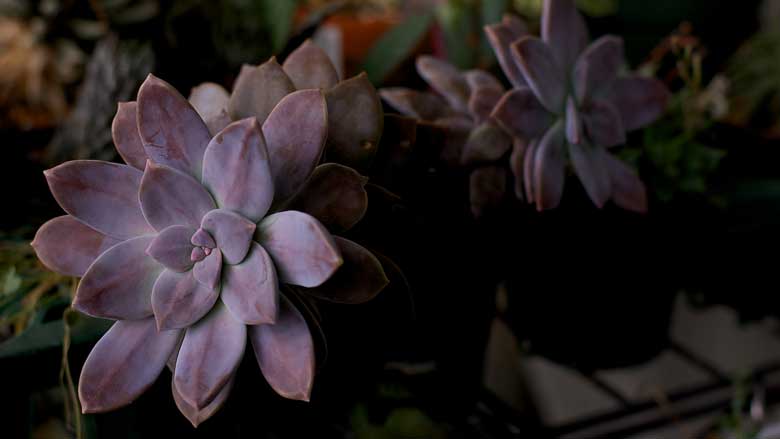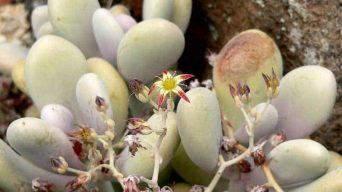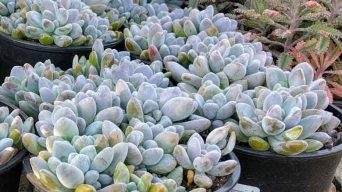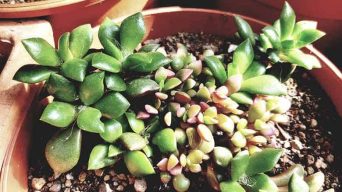Interested in a succulent that’s beautiful and easy to care for?
Graptopetalum superbum is one of the most popular succulents because it’s so easy to grow. It can be grown indoors or outdoors, in full sun or partial shade.
This might be a perfect choice if you want an easy-to-care-for plant with stunning flowers. You won’t regret adding this beauty to your home!
Learn how to take care of the Graptopetalum superbum succulent plant and how to propagate it so you can grow your own plants.
Overview
Graptopetalum superbum, formerly known as Graptopetalum pentandrum subsp. superbum is one of the most beautiful succulent plants in existence.
This perennial succulent is even commonly known as the ‘Beautiful Graptopetalum’.
The rosettes are open, flat, and up to 5 inches (12.5 cm) in diameter, with fleshy lavender to pink leaves that cluster at the end of thick stems.
Old Graptopetalum superbum plants can reach up to 7 feet (2.1 m) in height. However, if grown in full sun, this plant stays relatively small.
During late winter or early spring, this plant will sprout with an inflorescence that reaches up to two feet (60 cm) tall and features small star-shaped flowers marked with red on the tips of its yellow petals.
How To Care for Graptopetalum Superbum
Graptopetalum superbum care is easy when you know how to care for it.
When you keep the plant in good shape, you will have a beautiful and long-lasting houseplant that you will enjoy having around your home.
Below you’ll find the essential information you need to know about caring for Graptopetalum superbum.
Sun Exposure & Light Requirements
The Graptopetalum superbum is perfect for any garden, and it will thrive in full sun or partial shade.
This Graptopetalum species will tolerate full sun, but you must always protect them from direct sunlight.
Sunburn is very common if you are not careful, so you must make sure you provide your Graptopetalum superbum with ample shade for a few hours every day if you live in extreme sunlight areas.
You want to place your Graptopetalum superbum directly in full sun or under moderate sunlight for 8 hours minimum per day.
It’s also fine if you can only give it 3-5 hours of bright light, which will still be enough time for this plant to thrive.
You want to place this plant indoors in a window that receives 5-6 hours of indirect sunlight.
Watering Requirements
The Graptopetalum superbum doesn’t require much water, and you need to allow it to dry between waterings.
In hot weather during the summer months, you should check your Graptopetalum superbum every day. Water if you notice the soil is getting dry and give it a good soaking.
Overwatering can kill your Graptopetalum superbum, so you want only to water enough to moisten the soil.
Never allow your Graptopetalum superbum to sit in water. Water it, and then you want to remove the surface moisture gently.
To water your Graptopetalum superbum, you want to avoid getting the leaves wet. Watering from above when it isn’t raining can cause rot spots on the leaves.
Water at the base of the stem near where it meets the soil and let that water seep out slowly so you don’t create puddles around your plants.
Soil Requirements
You will need either a sandy soil or cactus and succulent potting mix for the Graptopetalum superbum plant.
The soil should be well-drained with the capacity to hold moisture but not too wet, or you will have a squishy mess.
With any succulent mix, you must make sure you add sand or gravel as grit to the mix. Graptopetalum superbum’s roots do not have an extensive root system, so you will need to help it by adding gritty porous soil that will increase water drainage from the soil.
A good rule of thumb is to add a handful of sand or gravel for every gallon you fill with potting soil.
Add more grit if you feel you have too much soil and not enough sand/gravel, or you will be left with a swampy mess!
Temperature and Humidity
Graptopetalums prefer growing at temperatures between 65°-75 °F (18°-24 °C), although you can tolerate higher temperatures between 80°-90° F (27°-32 °C).
The temperature range is acceptable for the plant as long as it does not drop below 50 degrees Fahrenheit (10 °C).
Graptopetalums also prefer humidity levels of 50% – 80%. You can achieve this by growing the plants on trays of damp gravel.
Contrary to popular belief, you do not need to mist Graptopetalums because you should be keeping them in their humid environment, as described above.
If you do, you may cause your plants to develop root rot.
Fertilizing
Graptopetalum superbum plants that you are growing as a houseplant or you’re propagating cuttings from; you don’t need to fertilize at all.
If you’re growing a Graptopetalum superbum plant outdoors, you should fertilize the established plants every spring — but you only need to use a ¼ strength dilution of balanced fertilizer for this.
We recommend you don’t fertilize the Graptopetalum superbum plant until you notice it grows new leaves.
Potting and Repotting
The Graptopetalum superbum succulent can be planted in the spring or summer.
Choose a pot 3-4 inches wider than the diameter of the plant you are planting, with excellent drainage holes, and clean it thoroughly with water before adding soil to it.
Gently remove the Graptopetalum superbum from its previous pot, and you should do it carefully to avoid damaging its roots.
Before you fill your new planter, add a gravel layer at the bottom. It will help you in preventing the pots from getting waterlogged, and you can avoid root rot.
The best soil you can use for this plant is a cactus mix, you can use your favorite one or make your own.
Place your new planter in a bright place, and you can place your Graptopetalum superbum in an area where you get sunlight for most of the day.
After you have planted your Graptopetalum, you should water it weekly or whenever the soil feels dry.
Pruning
You can prune your Graptopetalum superbum plant’s leaves, and they will grow back quickly due to their fast growth rate.
If you would like, you can trim off the bottom of your potted plant so that you create a new side shoot for your plant.
This is referred to as “topping” by many experienced growers. Topping is suitable for thickening up tall plants and helping keep them bushy instead of getting scraggly-looking branches towards the top of the pot.
It would be best if you pruned the top branches of your plants as you see fit. Dead, dried leaves should also be removed.
If you are new to succulent plants, you may not want to remove any leaves, and you can let your plant grow naturally without trimming or removing any leaves at all.
This is fine too, since you will not harm your plant in any way by not pruning it.
However, Graptopetalum superbum plants are very forgiving and will recover from most mistakes you may make during care and propagation.
Pests
You should be aware of common pests and know how to deal with include aphids, mealybugs, scale insects, and spider mites.
- Aphids are small, and you can get rid of them by dabbing them with cotton or a chemical pesticide (be sure you check that this is not harmful to your plant before you apply it).
- Mealybugs are usually found in crevices on the stems; you can use insecticidal soap to eliminate these.
- Scale insects look like small bumps on your plant; you can also use insecticidal soap.
- Spider mites are easily identified by the webbing they produce on the plant, and you should dab them with water to see them. Some other good ways to get rid of spider mites include using insecticidal soap or oil sprays.
Diseases
Some common diseases you may come across include leaf spot, powdery mildew, and rust.
- Leaf spot occurs when you don’t water your plant enough, and you can fix this by making sure you water your plant regularly.
- Powdery mildew is a fungus that grows on the tops of leaves; you can identify it by the white powder-like substance it produces on top of the leaves. This is easily treated with fungicide spray for plants.
- Rust occurs on new growth, and you can identify it by circular or oval spots of red or orange color; you should get rid of rust by dabbing the affected area with a paper towel soaked in rubbing alcohol.
The best way to prevent pests and diseases is to keep your plants healthy; you can do this by providing the right amount of light and water.
You should also avoid over-watering your plants as this can lead to root rot.
Bugs, mites, and diseases are a part of gardening you should always be aware of, but you shouldn’t let it stop you from enjoying your garden.
How to Care for Graptopetalum Superbum in Winter
Graptopetalum superbum winter care is relatively easy in that you will need to ensure the plant receives ample light, water, and warmth.
You should also avoid exposing your Graptopetalum superbum to extreme temperatures, especially cold weather.
If you grow Graptopetalum superbum plants outdoors, you may leave them outside until the soil freezes solid; you can still water them as you usually would.
You should bring the plant indoors if you experience a hard frost or extended cold weather (which you can check using the AccuWeather extended forecast for your area).
You can easily care for your indoor Graptopetalum superbum in winter by providing it with plenty of sunlight through a south-facing window, and you should always keep the plant warm (minimum 55 degrees F/12.78 degrees C).
How To Propagate Graptopetalum Superbum
Graptopetalum superbum can be easily propagated by leaves, offsets, or seeds.
How To Propagate by Leaves
- You will then cut your plant’s leaves off just about an inch or two above where a leaf connects with the stem; you do not want any leaves connecting to the stem.
- Allow your Graptopetalum leaf cuttings callous over for two to three days.
- Place your freshly cut Graptopetalum leaves in soil that has been well watered; you do not want the soil to be dry.
- Allow your callused leaf Graptopetalum cuttings to grow for 6-8 weeks, and you will have your first batch of fully rooted baby Graptopetalums.
- You can then remove your newly rooted baby Graptopetalums and place them in the planters you intend to have your new Graptopetalum superbum grow in.
Propagating by Offsets
- You need to use your fingernails or garden shears to remove the offsets attached to the mother plant.
- Allow your baby Graptopetalum plants to callous over for 2-3 days before planting them into the pots you intend for them to grow in.
- Allow your baby Graptopetalum cuttings to grow for 6-8 weeks, and you will have your first batch of fully rooted baby Graptopetalums.
- You can then plant your new Graptopetalum superbum in planters.
How To Propagate by Seeds
- Allow your Graptopetalum superbum to grow on your pots for 2-3 years before you harvest your seeds.
- Allow your Graptopetalum seeds to dry out for a couple of days; you do not want your seeds to be too green.
- You may need to soak your dried Graptopetalum seed overnight before you can successfully begin germinating them with your seed starting mix.
- You can use your hand to sow your seeds in the pots you will be growing your Graptopetalums.
- Allow your baby Graptopetalum plants to grow for 6-8 weeks, and you will have your first batch of fully rooted baby Graptopetalums.
- You can then transplant the rooted baby Graptopetalums into planters of their own.
Is the Graptopetalum Superbum Toxic?
The Graptopetalum superbum plant is not toxic to humans and pets.
However, you should always use gloves when handling the Graptopetalum superbum plant because you might be sensitive to some of its oils.
Final Thoughts
If you’re looking for a new addition to your home or office space, then look no further than Graptopetalum superbum!
You won’t regret adding this beauty into your life because it is an attractive decoration and provides excellent benefits such as drought tolerance and low maintenance!







